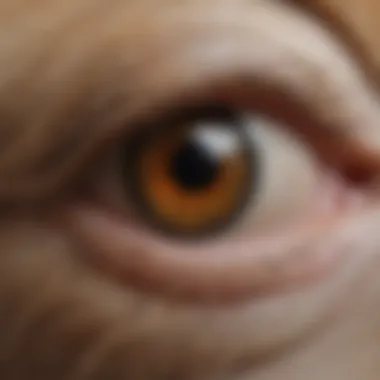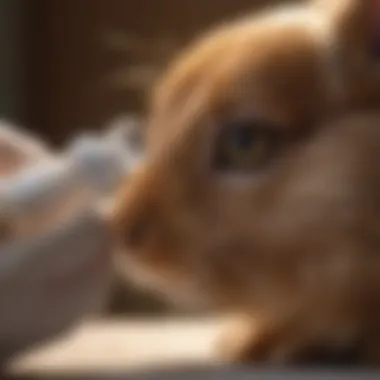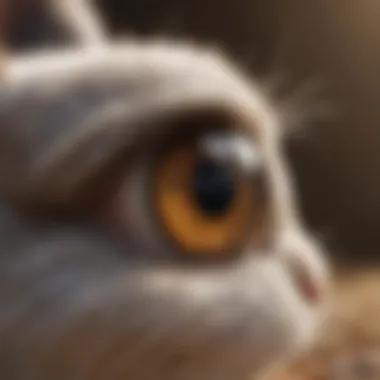Understanding Eye Drops for Rabbit Eye Infection Treatment


Intro
Eye care is an often overlooked aspect of rabbit health. Just like any other pet, rabbits can suffer from various health issues, including eye infections. These infections can be caused by several factors, such as bacteria, viruses, or even environmental irritants. Understanding how to recognize the symptoms and administer proper treatment is crucial for maintaining your rabbit's health.
In this guide, we will focus on the essential role of eye drops in treating eye infections in rabbits. We will explore the symptoms of such infections, the importance of veterinary intervention, and the proper techniques for administering eye drops. Furthermore, we will highlight preventive measures to promote overall eye health in your pet. This is intended as a comprehensive resource for pet owners, veterinarians, and animal enthusiasts.
Understanding Your Pet
When it comes to caring for your rabbit, understanding their behavior and needs is vital. Analyzing the specific traits across different rabbit breeds can help in this regard.
Pet Behavior Basics
Rabbits are social animals. They are known to bond closely with their owners and require space to explore and exercise. They communicate through body language and specific vocalizations. Recognizing these signs can help identify if something is amiss, such as discomfort or illness.
Common Breed Characteristics
Different breeds may exhibit unique characteristics. For example, larger breeds like the Flemish Giant may have different health issues compared to smaller breeds like the Netherland Dwarf. Knowledge of common health concerns within your rabbit's breed can prepare you for any potential eye problems.
Species-Specific Needs
It is essential to meet the specific needs of your rabbit. Their environment should be clean, spacious, and comfortable. This not only allows for normal behavior but also reduces the risk of infections, including those affecting the eyes.
Health and Wellness
Rabbits thrive with proper health care and regular check-ups. Observing their general well-being and taking preventive steps is crucial.
Routine Vet Check-ups
Establishing routine veterinary visits is a key component of rabbit care. Vets can provide valuable insights into your rabbit’s health, including any signs of eye infections or other underlying issues.
Recognizing Signs of Illness
It is important to be vigilant for signs that your rabbit may be experiencing an eye infection. Symptoms can include:
- Red or swollen eyes
- Discharge, which may be clear or cloudy
- Excessive tearing
- Squinting or sensitivity to light
Prompt recognition of these signs can initiate early treatment and improve recovery chances.
The sooner you act, the better the outcome for your rabbit.
Treatment with Eye Drops
Eye drops are vital in treating infections. Various types are available, each suited for specific conditions. It is critical to consult a veterinarian to determine the appropriate product.
Administering Eye Drops Safely
Administering eye drops to a rabbit may seem daunting, but with patience, it can be done successfully. Here is a simple approach to follow:
- Ensure the surrounding area is calm and quiet.
- Hold your rabbit securely yet gently.
- Tilt their head back slightly, exposing the eyes.
- Administer the drops as prescribed, being careful not to touch the eye with the dropper.
Potential Side Effects
While eye drops can be beneficial, they may also have side effects. Common reactions include:
- Temporary stinging
- Mild redness after application
- Increased tearing or discharge
Being aware of these side effects can help you monitor your rabbit post-treatment.
Preventive Measures
Preventive care is as crucial as treatment. Regular hygiene practices like cleaning around the eyes can minimize the risk of infections. Adding environmental enrichment and proper nutrition also contributes to overall eye heath.
Awareness and education empower pet owners to improve their rabbit’s well-being. By understanding the importance of eye care, you help ensure a longer, healthier life for your beloved pet.
Foreword to Rabbit Eye Infections
Eye infections in rabbits can escalate quickly from a minor irritation to a significant health issue. Understanding these infections is crucial for any rabbit owner. Being aware of the common symptoms and potential causes can lead to timely intervention. Eye health in rabbits serves as a window to their overall well-being. Whenever they show signs of discomfort, immediate attention is necessary. This section aims to provide a thorough foundation on rabbit eye infections.


Overview of Common Eye Problems
Rabbits can face various eye problems, which may include conjunctivitis, corneal ulcers, and glaucoma. Each of these conditions presents its own challenges and risks. Conjunctivitis, for instance, is an inflammation that can be caused by allergies or infections. A sudden change in the environment can trigger this, making it critical to monitor any changes.
Corneal ulcers develop when there is any injury to the surface of the eye. This can lead to severe pain and discomfort for the rabbit. It is essential to identify this as quickly as possible to provide appropriate treatment.
Glaucoma is another condition that affects the eye, indicated by increased pressure within the eye. Recognizing this early is vital, as it can lead to permanent damage if left untreated.
Being familiar with such conditions allows rabbit owners to act promptly, protecting their pets from potential harm.
Significance of Eye Health in Rabbits
Maintaining good eye health is fundamental to a rabbit's quality of life. Their eyes are not just for vision; they also provide insight into their general health. An energectic and healthy rabbit often has bright and clear eyes. Any discoloration, excessive tearing, or swelling can signal distress.
The role of an owners is indispensable. Regular checking of a rabbit's eyes can help catch early signs of issues. Healthy eyes often reflect a proper diet, a clean living environment, and effective stress management. Conversely, neglecting eye health can lead to serious complications. Eye infections, if not treated timely, can result in pain or even loss of vision.
Eye health in rabbits is a critical aspect that should never be overlooked.
Thus, awareness of the significance of eye health fosters responsible pet ownership. Comprehensive knowledge of potential issues prepares owners to ensure their rabbits live healthy and fulfilling lives.
Identifying Symptoms of Eye Infections
Recognizing the signs of eye infections in rabbits is crucial for a timely response. Early identification can prevent further complications and help maintain your pet's overall health. Rabbits cannot communicate discomfort verbally, making it essential for owners to watch for visual cues. Understanding the symptoms can lead to quicker veterinary consultation and better treatment outcomes.
Common Signs of Eye Infection
The symptoms of eye infections in rabbits vary, but certain indicators are typical. A common sign is excessive tearing or discharge from one or both eyes. Discharge may be clear or cloudy and can sometimes be greenish or yellowish, indicating a possible bacterial infection. Other symptoms to watch include:
- Swelling around the eyes
- Redness or irritation of the conjunctiva
- Squinting or holding the eye partially closed
- Increased blinking or pawing at the eye
- Cloudiness in the eye, which may suggest deeper issues
Recognizing these signs early can allow for swift medical intervention, improving the chances of a positive outcome.
Behavioral Changes Indicating Discomfort
Behavioral changes can provide insight into a rabbit's condition. When experiencing eye pain or infection, rabbits may become more reclusive. They might avoid social interactions or refuse to engage in normal activities like eating or grooming. Other noticeable behavioral indicators include:
- Lethargy: The rabbit may appear more tired or inactive than usual.
- Hiding: A previously social rabbit may begin to retreat to darker corners of its environment.
- Loss of appetite: Changes in eating habits can signal that the rabbit is unwell or in discomfort.
Observing these changes is essential for assessing your rabbit's health. A proactive approach is beneficial, as it allows you to seek veterinary assistance early, possibly before more serious symptoms arise.
Being attentive to your rabbit's health and behavior fosters a deeper bond and ensures their well-being.
Causes of Eye Infections in Rabbits
Understanding the causes of eye infections in rabbits is crucial for pet owners. These infections can lead to serious health issues if not addressed promptly. Numerous factors contribute to the development of these infections. Knowing them can help you take preventive actions and seek timely veterinary assistance.
Bacterial and Viral Infections
Bacterial infections are a significant reason why rabbits experience eye problems. Common bacteria like Pasteurella can enter through scratches or other injuries. Viruses can also play a role. Conditions like viral conjunctivitis often stem from underlying viral diseases. These pathogens thrive in unsanitary conditions and can spread quickly among multiple rabbits. Regular monitoring for signs of infection is essential.
Environmental Factors Leading to Infections
The environment where your rabbit lives can directly impact its eye health. Poor hygiene, dust, and allergens can create a breeding ground for infections. For instance, a dirty cage or contaminated bedding can cause irritation and lead to infections. Additionally, changes in weather or exposure to drafts may exacerbate existing conditions. Maintaining a clean and safe environment minimizes these risks.
Underlying Health Issues
Certain health issues can predispose rabbits to eye infections. For example, dental problems can lead to abscesses, which may affect the eye area. Other systemic conditions like diabetes or immunosuppressive diseases weaken a rabbit's ability to fight infections. Therefore, routine health check-ups are vital. A veterinarian can identify and treat these underlying issues, which aids in preventing eye infections effectively.
It is essential to observe your rabbit's behavior and physical condition regularly. Early detection leads to better outcomes and maintains your pet's well-being.
Consulting a Veterinarian
Consulting a veterinarian is vital when managing eye infections in rabbits. Rabbits are delicate creatures, and their eye health can significantly affect their overall well-being. A professional can offer a precise diagnosis, guiding the most effective treatment approach. This article emphasizes that while some symptoms may seem obvious, only a trained eye can identify the underlying issues that may not be apparent to pet owners.
Importance of Professional Diagnosis
A professional diagnosis allows for the accurate identification of the specific type of eye infection affecting the rabbit. Each infection, whether caused by bacteria, viruses, or other factors, may require different treatments. A veterinarian can assess the severity of the infection and guide the use of appropriate medications, such as eye drops. This process is essential to avoid misdiagnosis, which can lead to ineffective treatment and prolong the animal’s discomfort.


What to Expect During the Veterinary Visit
Visiting the veterinarian can bring some apprehension, but understanding what to expect can ease that anxiety for both the pet and owner.
Physical Examination
During the physical examination, the veterinarian will closely inspect the rabbit’s eyes, searching for signs of infection. This hands-on approach is beneficial as it allows the vet to see firsthand any unusual discharge, swelling, or other irregularities. The key characteristic of this examination is its direct assessment of the rabbit's eye condition.
The unique feature here is the immediate interaction between the rabbit and the vet, which can yield quick insights into the rabbit's health. This method provides several advantages, including understanding the extent of the infection and evaluating the rabbit's overall health.
Diagnostic Tests
Diagnostic tests complement the physical examination and are often necessary to confirm the diagnosis. These may include culture tests to identify specific pathogens affecting the rabbit’s eyes. This characteristic of diagnostic tests significantly enhances the treatment plan, making it more targeted and efficient. An essential feature of these tests is their ability to provide conclusive evidence of the presence of infection.
While they do involve additional steps, the benefits of accurate identification far outweigh any inconvenience. Performing these tests can lead to tailored treatments that are more likely to resolve the infection effectively, thus ensuring better health outcomes for the rabbit.
The accurate diagnosis from a veterinarian not only fosters effective treatment but also ensures peace of mind for the pet owner.
Types of Eye Drops for Rabbits
Understanding the various types of eye drops available for treating eye infections in rabbits is crucial for effective care. Each category of eye drop serves a unique purpose, targeting specific problems related to ocular health. This section explores antibiotic, antiviral, and anti-inflammatory eye drops, highlighting their benefits, considerations for use, and the situations in which they are appropriate.
Antibiotic Eye Drops
Antibiotic eye drops are essential when dealing with bacterial infections in a rabbit's eyes. These drops work by targeting and eliminating harmful bacteria that can lead to severe infections. Common antibiotic eye drops for rabbits include the likes of Gentamicin and Ofloxacin.
When administering antibiotic eye drops, pet owners should observe the following points:
- Consultation is Key: Always seek veterinary advice before starting treatment. A vet is essential for accurately diagnosing the type of infection.
- Dosage and Frequency: Following the vet's recommendations for dosage and frequency is crucial. Overusing antibiotic drops can lead to resistance, making infections harder to treat.
- Monitoring Progress: Keep an eye on any changes in your rabbit's condition after beginning treatment. If there is no improvement, returning to the vet for a follow-up is necessary.
Important: Using the wrong type of eye drops can worsen an infection. Always rely on proper diagnoses.
Antiviral Eye Drops
For eye infections caused by viral agents, antiviral eye drops come into play. Unlike bacterial infections, viral infections can be trickier because most medications focus on symptom relief rather than curing the virus itself. Common antiviral drops include Idoxuridine and Acyclovir.
Here are key points regarding their use:
- Timing Matters: Early intervention can significantly improve outcomes in viral infections. Be vigilant for symptoms and consult a vet promptly.
- Symptomatic Relief: Antiviral drops help reduce discomfort and swelling. They are not a cure but can assist in managing the symptoms associated with viral infections.
- Follow-up Care: Regular veterinary check-ups are important to assess the progress of treatment and make any necessary adjustments.
Anti-inflammatory Eye Drops
Anti-inflammatory eye drops aim to reduce swelling and redness around a rabbit's eye. These drops help alleviate discomfort and promote healing. Products that may be prescribed include Prednisolone acetate and Ethyl estradiol.
Important considerations include:
- Use with Caution: While these drops are effective, they should be used cautiously as they can mask symptoms of more serious issues. Always follow veterinary guidance.
- Combination Therapy: Sometimes, anti-inflammatory drops may be used alongside antibiotic or antiviral treatments for better effectiveness.
- Observation of Side Effects: Watch for side effects or changes in your rabbit's behavior once the drops are administered. Any concerning signs should prompt a visit to the veterinarian.
Administering Eye Drops to Rabbits
Administering eye drops to rabbits is a critical step in managing eye infections. Proper application ensures that the medication is effective in treating the infection and aids in the recovery process. Misapplication of drops can lead to discomfort and stress for the rabbit, potentially making the treatment less effective. In this section, we focus on key elements that influence the safe and efficient administration of eye drops.
Steps for Safe Administration
Administering eye drops may seem straightforward, but it requires care and attention. Here are the essential steps to follow:
- Preparation: Ensure you have everything ready before bringing the rabbit in. You need the eye drops, a clean towel, and possibly a helper to hold the rabbit securely.
- Positioning the Rabbit: Hold the rabbit securely but gently. You can either place them on a soft surface or hold them in your lap, ensuring they feel stable and secure.
- Cleaning the Eye (if necessary): If there is discharge around the eye, use a clean, damp cloth to wipe it away gently. This action will help prevent additional irritation.
- Applying the Drops: Hold the dropper above the eye. Gently squeeze the dropper to release the appropriate number of drops. Aim to place the drops directly onto the eye surface, avoiding a direct hit to the eyeball, if possible.
- Aftercare: Once the drops are administered, observe the rabbit for any immediate reactions. Make sure to praise or comfort the rabbit to make the experience less stressful.
Following these steps can lead to a more positive experience for both you and the rabbit. Consistency in application can greatly improve recovery outcomes.
Tips to Reduce Stress During Application
Applying eye drops can be stressful for rabbits. Here are some tips to minimize their anxiety and make the process smoother:
- Create a Calm Environment: Start in a quiet area, free from distractions. Dim the lights if possible and eliminate loud noises.
- Use Familiar Surroundings: If your rabbit is more accustomed to certain locations or surfaces, try administering the eye drops there to reduce their anxiety.
- Take it Slow: Move slowly and speak to the rabbit in a calm manner. Rushing the process can heighten their stress.
- Provide Comfort: After administering the drops, hold or pet the rabbit gently. This helps reassure them and makes future applications easier.
- Reward Behavior: After the application, provide a small treat. Associating the experience with something positive can help reduce fear in future applications.
By implementing these strategies, you can help transform the eye drop application process into a more manageabale experience for your rabbit.


Possible Side Effects of Eye Drops
When administering eye drops to rabbits, understanding possible side effects is crucial. While these medications are intended to address specific conditions, they can also lead to undesirable reactions in some cases. Recognizing and acknowledging these side effects helps pet owners monitor their rabbit's condition and ensures prompt attention if needed.
Common Side Effects
Common side effects of eye drops can vary based on the type of medication used. Generally, rabbits may experience:
- Irritation: This can manifest as redness, swelling, or excess tearing around the eye area.
- Discomfort: Some rabbits may show signs of discomfort, such as squinting or pawing at their eyes.
- Temporary Blurred Vision: Immediately after administration, the eye may feel blurry; this usually resolves quickly.
- Allergic Reactions: In rare cases, some rabbits may develop an allergic response, presenting symptoms like hives or swelling.
It is essential to observe the rabbit closely after administering the drops. Any noticeable change in behavior or eye condition should be assessed.
When to Contact a Veterinarian
Monitoring your rabbit after eye drop application is vital. If you observe any of the following scenarios, contacting a veterinarian is highly recommended:
- Increased Irritation: If redness or swelling worsens instead of improving, this may indicate an adverse reaction.
- Persistent Discomfort: Continuous squinting, rubbing, or excessive tearing that does not subside warrants professional advice.
- Signs of Allergies: If you notice swelling around the face or body, or other allergy-like symptoms, seek veterinary attention immediately.
- Failure to Improve: If the initial reason for administering the eye drops does not show signs of improvement within a few days, consult a veterinarian for further evaluation.
Always err on the side of caution. It is better to check with a veterinarian than to assume everything is fine.
Understanding the side effects associated with eye drops helps improve the management of eye health in rabbits. By staying informed and vigilant, owners can ensure their pets receive the best possible care.
Preventive Measures for Rabbit Eye Health
Eye health in rabbits is crucial, as their eyes are sensitive and prone to infections. Preventive measures play a significant role in maintaining ocular health. Implementing strategies to protect and promote good eye health can help reduce the risk of infections and associated complications. In this section, we will explore some key preventive measures that rabbit owners can take.
Regular Eye Check-ups
Regular eye check-ups are essential for ensuring the well-being of rabbits. Veterinarians can detect early signs of infection or other ocular issues that may go unnoticed by owners. During these check-ups, the veterinarian thoroughly examines the eyes, looking for signs of abnormalities such as redness, discharge, or swelling. The benefits of regular eye check-ups include:
- Early detection of potential problems.
- Professional advice on eye care.
- Monitoring of existing conditions.
- Development of a tailored health plan.
It is important to schedule these check-ups at least once a year, and more frequently if your rabbit has a history of eye issues.
Maintaining a Clean Living Environment
A clean living environment is crucial to prevent eye infections in rabbits. Bacteria and debris can accumulate in their surroundings, leading to potential irritation and infection. Here are some steps to maintain cleanliness:
- Regular cleaning of the cage: Ensure that the cage is free from urine, feces, and uneaten food.
- Replace bedding regularly: Use clean bedding materials and remove damp or soiled areas promptly.
- Monitor dust and allergens: Keep the area dust-free to reduce respiratory irritants and protect their eyes.
By keeping their habitat clean, you provide a healthier living space that minimizes the risk of eye infections and other health issues.
Proper Nutrition and Hydration
Proper nutrition and hydration are fundamental aspects of maintaining eye health in rabbits. A balanced diet supports not just the eyes, but also overall well-being. Nutritional deficiencies can lead to various health problems, including susceptibility to infections. Key points to consider include:
- Hay as a staple: High-quality hay should form the core of a rabbit's diet, providing essential fibers that assist digestion and eye health.
- Fresh fruits and vegetables: Incorporate leafy greens and a limited quantity of fruits for additional vitamins and hydration.
- Clean fresh water: Ensure that clean water is always available and refreshed daily.
A well-nourished rabbit with adequate hydration is less likely to face health issues, including eye infections. Prioritizing these preventive measures will promote a healthier and happier pet.
Culmination
In the realm of rabbit care, understanding the application and effects of eye drops is critical for maintaining ocular health. This article has highlighted various key aspects regarding eye infections in rabbits, addressing symptoms, diagnosis, and effective treatment options.
Recap of Eye Care in Rabbits
Eye care in rabbits is often overlooked, yet it plays a significant role in their overall health. Rabbits can suffer from a range of eye problems, from minor irritations to severe infections. Having a keen eye for unusual behaviors and symptoms can lead to early detection, which is crucial.
- Common symptoms to watch for include:
- Redness and swelling around the eyes
- Discharge, either watery or pus-like
- Frequent blinking or squinting
Visiting a veterinarian is recommended if any concerning signs are present. Diagnosing the issue correctly leads to better treatment outcomes, especially when eye drops are involved. It's essential that pet owners understand the different types of eye drops, such as antibiotics, antivirals, and anti-inflammatory options. Each plays a unique role in addressing specific conditions of eye infection.
Encouraging Proactive Eye Health Management
Proactive management of eye health in rabbits is advantageous. Regular check-ups with a veterinarian can prevent minor issues from escalating into serious health problems. Understanding the habitat of the rabbit is also important; a clean living environment reduces the likelihood of infections.
Key considerations include:
- Ensuring adequate ventilation in their living area.
- Keeping bedding clean and dry.
- Providing a balanced diet rich in nutrients.
By taking these steps, pet owners can significantly improve the quality of their rabbits’ lives. They should advocate for rabbit eye health by informing themselves about abnormalities, seeking early veterinary care, and adhering to prescribed treatments. Maintaining a focus on eye health can lead to longer, healthier lives for rabbits.







